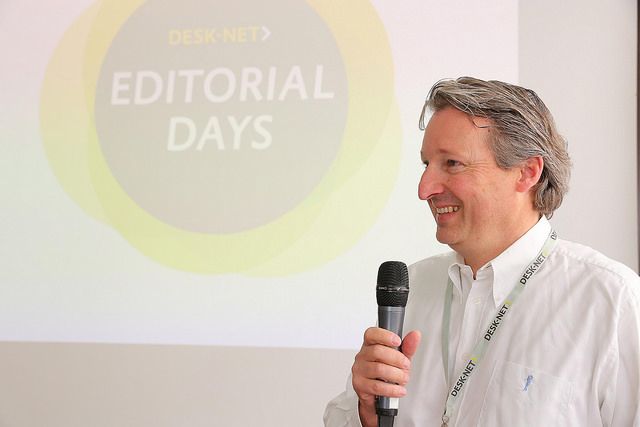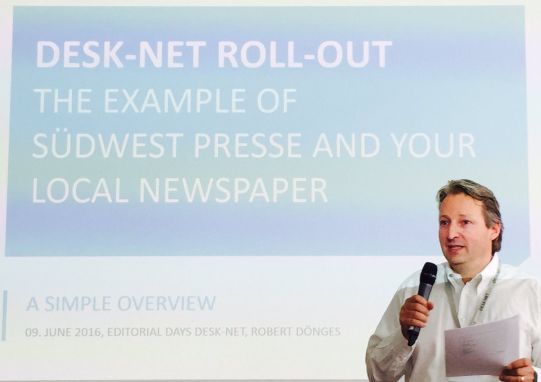Südwest Press Explores the Potential of Their Desk-Net Roll-out

Love to implement newsroom management and editorial calendaring across your newsrooms but uncertain about what is involved? Robert Dönges, senior project manager at Südwest Presse walks us through the process, its pitfalls, and its learning points
The project - who, why, how
Südwest Presse is not only a daily newspaper based in Ulm, it is also a Zeitungsverbund – a collective publisher for over 20 local publications that share regional and national features. That means a lot of news desks, and a lot of potential for duplication.
Which is why the company decided to implement Desk-Net editorial scheduling software across all its newsrooms, starting in October 2013. The first step involved introducing the idea to more than 300 employees, divided up into 19 groups and each one trained for 90 minutes in the principles and potential of the new approach.

“Over two months we trained 300 editors in the new system,” explains Robert Dönges, senior project manager at Südwest Presse.
“That meant presenting up to three times a day and not just offering up-front teaching about Desk-Net but also argue the case for using it. That was sometimes near slapstick with some older colleagues saying 'this is not going to help' but fortunately my colleagues decided to go for it.”
That first round of introductory training was followed up with a two month training period at the beginning of 2014 aimed at smoothing out practical problems and work processes with the new Desk-Net users.
Following on from this training phase, Südwest Presse entered a second phase of the roll-out as the publisher extended Desk-Net's reach out to their print partners and developed a workflow to notify planned stories right across the range of their news partners.
A third phase began in April 2014 as they began multi-site content planning (with notifications to the main news desk to keep everyone singing from the same song sheet) and further agreements on work processes.

The results
In concrete terms that third phase meant a policy of identifying two stories as the top stories of the day, and marking them up as such by 6pm the evening before their intended issue (i.e. by Monday evening for the Wednesday edition).
That means no paper-based rosters, no printed spreadsheets fluttering around the newsroom and harmonised planning across national and local desks. “All previous planning tools were replaced,” explains Dönges, “and this has simplified and unified news structure and speeded up planning while creating opportunities with editors having mutual access to stories.”
It sounds like a lot of work, something Dönges acknowledges as he addresses the audience at the Desk-Net Editorial Days; “I shouldn't really be here today at all as they are still rolling out the new system.”
The impact is dramatic. “New conferences have been moved forward by thirty minutes and the evening conference has been cancelled altogether,” explains Dönges. “Up until a year ago we had huge meetings in the morning, with lots of sheets of paper, as everyone presented stories.
By the end of which everyone went their different ways to go to lunch. Now the news conference is limited to 45 minutes and everyone presents just five stories.”
Using Desk-Net also means story ideas or schedules can be modified on the fly during the editorial conference and the whole system of asynchronous parallel planning by email, word of mouth, or Post-It notes has been eliminated. Planning is now standardized, streamlined, and available in real time to all concerned.
The lessons learned

Tip 1
The first lesson it that there is no such thing as one-size-fits-all in publishing and what works for Südwest Press may not be the right strategy for another publisher. Which is why Robert Dönges first tip is to ask yourself;
"Who will have the Desk-Net administrative responsibility? Will it be the users, meaning the managing editor or the editorial service office? Or should it be the in-house IT department?"
Dönges points out that the latter may mean battling with editorial distrust of IT.
Tip 2
He goes on to suggest that the way to find out is to “try Desk-Net in a group first. Adjust the publication platforms and categories to find what formats you need, whether the admin rights fight the purpose, whether there are problems in understanding and workflow. Then develop these learnings into a simple, practical standard as you introduce the tool further. One lesson we learnt was that each desk works differently.”
Tip 3
The next learning point was to find a deputy. “Two heads are better than one especially during or after a three-week holiday break.”
Tip 4
“Editors are often reluctant to accept advice – I can say that because I am one – and resistance is to be expected. As creative spirits planning is not something they are used to and they need to be convinced of its usefulness. The argument you will keep hearing is that 'we are a daily newspaper so we can't plan.'
My answer to that was to take a copy of the current issue and mark up all the content which had been written ahead of time. It usually makes up about 80 per cent of the issue.”
Tip 5
Put someone in charge in every department. “This can be the manager, the editor's assistant, or the secretaries but that person is the key contact in that specific department and is in charge of the administration. That way you don't have to add every freelancer to the system yourself.”
Tip 6
“Don't expect praise or appreciation. Think of an absence of complaints as being praise.”
Tip 7
“Push for further work development in your company using Desk-Net. Demand further planning steps from your Editorial team (such as conferences, shifts etc.). Simplify, the workflow with the planning tool. Oh, and last but not least, don't try to ban paper.”
Tip 8
“Follow through! I can't stress the importance of this enough. Prepare a meeting once a year where all the desks, departments, editorial offices and various local news join in. Find out where the problems are. Demonstrate the benefits of new features and functions. Offer additional training. Experience shows that the face to face discussion brings a lot more benefit than chain e-mails.”
Those Top Tips in brief;
1. Set Administrative responsibility: editors or IT?
2. Do a preliminary test with a small group: Does theory meet the practical needs?
3. Find a trustworthy deputy
4. Prepare each training specifically.
5. Find a person in charge for each location
6. Don't expect praise
7. Push for further development
8. Follow through
Microsoft power point desk-net - dönges, robert - swp - 2016-06-09

